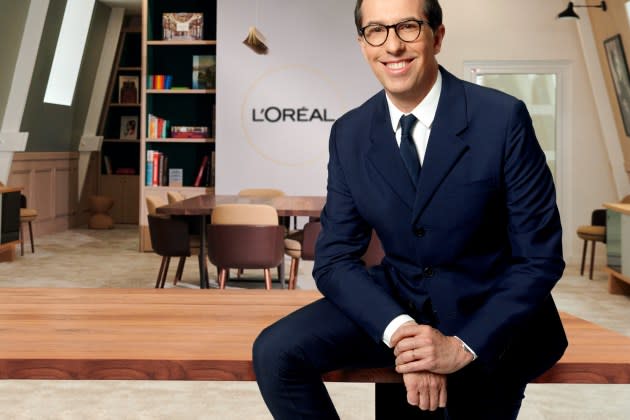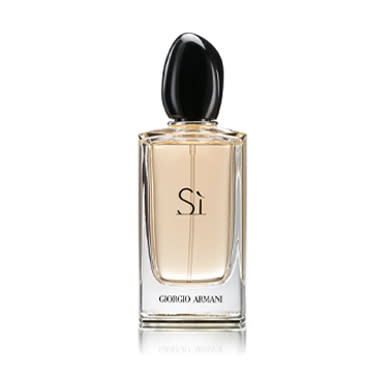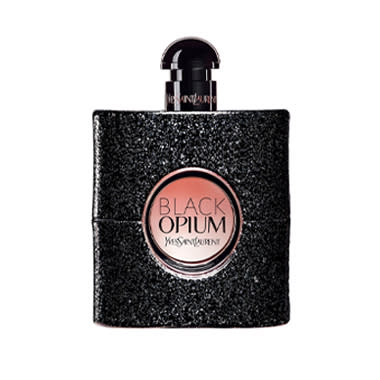L’Oréal’s Nicolas Hieronimus on Hitting the High Notes

As the chief executive officer of L’Oréal who has overseen record growth at the company during exceedingly tough times, Nicolas Hieronimus is no stranger to accolades. But being inducted into the Fragrance Foundation Hall of Fame hits a different note.
Perfume is a category that Hieronimus has a deep affinity for and has worked closely on during his career, particularly during his time as president of L’Oréal Luxe, where he oversaw the development of fragrances that reman bestsellers today in the global top 10 rankings, including Lancôme’s La Vie Est Belle, Giorgio Armani’s Sì, and Yves Saint Laurent’s Black Opium and Libre.
More from WWD
It’s particularly fitting that Hieronimus accepted the award at Alice Tully Hall in New York City’s Lincoln Center from Sì ambassador Cate Blanchett, who was nominated for an Academy Award last year for her role as a conductor in the film “Tár.” Hieronimus is a music aficionado, who makes a point of attending as many concerts as he can, including, most recently, Beyoncé’s Renaissance World Tour in Paris.
“I’m very passionate about music, and I see a lot of similarities between music and fragrance,” said Hieronimus, during an exclusive interview with Beauty Inc before being presented with the honor. “We talk about notes, accords, composition. There is a lot of commonality, and what makes it great is that just as what differs a hit song from a tune that will remain forgotten is this incredible alchemy between experience and know-how and science, and, at the same time, creative flair and the capacity to invent something new with ingredients that are already there.

“Fragrance is a very unique category, and, like music, fragrance creates emotions, and there is nothing more wonderful than that,” he added.
L’Oréal’s fine-tuned approach to the category is evident in its results. In 2022, while the global fragrance market’s sales increased 15 percent, L’Oréal saw a 25 percent jump.
Circana reports that prestige fragrance generated $20 billion globally across Europe, North America and Latin America for the 12 months ending in March, with double-digit growth sustaining in all markets with the exception of China.
For its part, L’Oréal outperformed the total fragrance market in the U.S., Canada, Italy, Spain, Argentina, Peru and China, and in the first quarter alone, its fragrance growth rates have outpaced the rates for total growth in Europe, the U.S. and Canada.
Here, Hieronimus shares the strategy behind the success, and how the group plans to continue the momentum in the year ahead.
What does being inducted into the Fragrance Foundation Hall of Fame mean to you?
Nicolas Hieronimus: It’s a great honor and I’m truly grateful to the Fragrance Foundation for giving me this award. I’m grateful for me, but more importantly for the teams and the recognition of L’Oréal, because in reality, I feel that my role is more like the conductor of a great creative orchestra. Our teams encompass the brand creative people; our olfactory department; our fragrance creation led by Karine Lebret, global vice president of scent science and fragrance design; our packaging department — because fragrance is also about creating objects of desire, almost pieces of art — and, of course, our external brand partners and the fragrance houses with whom we are working — IFF, Firmenich, Givaudan, Mane — who are our biggest partners. They are all included in the award. It’s great.
Fragrance has played an important role in your career trajectory — what is it about the category that you like so much?
N.H.: Beauty always has to play on two levels — the rational level, meaning performance, and on the emotional level. Fragrance actually plays on both sides.
When you talk about importance of fragrance on my career — of course it is true for fine fragrance, but other products as well. When I developed with my teams Garnier Fructis, we chose to have very unique fragrances that were very different from what was on the market, supporting the brand’s claims and positioning.
In beauty in general, fragrance plays that extra role in the emotion provided by the products. It is fascinating to work on fragrance because there is an element of alchemy, magic — there are many launches each year, but not many successes. I like the emotional side, but also the uncertainty of it. I love the magic and I love that it can enhance the performance and make people feel good about themselves.
But you have to be very humble with fragrance. Of course, we celebrate our successes, but there are fragrances that don’t work as well. There are a lot of intangibles.
During your time heading L’Oreal Luxe, the division launched a number of blockbusters, which remain bestsellers today — what were the key takeaways from your repeated wins, and what does it take to create a long-term success in the category?
N.H.: The number-one decision and key factor is to bet on quality — the quality of ingredients, the concentration, the naturalness. The quality doesn’t stop at the juice. It includes the packaging. Take La Vie Est Belle from Lancôme. The bottle with a smile was based on an old Lancôme fragrance drawn by the great Armand Petitjean. For Pochet, it was an achievement to attain that design on an industrial scale.
Overall, success is about quality and this blend of having something very unique and creative, and at the same time broad enough in its appeal to be a commercial success. In the end, a global leader in fragrance is a couple of points in market share, so you don’t need to please everyone, but a fragrance needs to have a strong personality that ideally matches with the brand personality.
La Vie is a happy fragrance in the name, in the color of the juice, in the juice itself, which embodies the positive positioning of Lancôme. Lancôme is about happiness, and La Vie is the epitome of happiness.
YSL’s Black Opium is also an innovation. It is one of the first coffee accords — that was disruptive and provocative, and we could say the same about YSL’s Libre or Paradoxe from Prada.
It is creativity, a bit of testing to make sure it pleases at least a few people and good alignment with the brand culture.
My number-one fear when I’m presented with a project is that this new juice or fragrance won’t bring anything to the market, that it’s déjà vu, as we say in France. When I was presented Black Opium, I loved it because I had never smelled it before and my teams were saying, at least some consumers like it and find it has a great personality. That was the the ideal equation — new, different, disruptive, that can find its target. And I love coffee personally — I drink five or six espressos a day.

How do you think about the balance between instinct/gut and analytics/testing in the category?
N.H.: Testing is only a reassurance. In the end, it is about creativity and trusting the experts, and frankly, I have total trust and immense respect for our olfactory team, as well as for the brand presidents who work on the fragrance brands. In the end, it is about having a vision and desire to create something new, an inspiration. The testing part is a reassurance that the fragrance will last, not on your skin, but as a success over time. The one thing you need to measure is not whether people like it or not, but whether they like to wear it more and more. We also check that the fragrance can also work in different parts of the world. Fragrance tastes are influenced by where you live and what you smelled in your childhood. It is very cultural, so you have to check that a given fragrance can appeal to American, French and now Chinese consumers.
Fragrance was an outstanding performer for the group in 2022 — up 25 percent. Can you drill down into some of the key drivers and whether you see the momentum continuing this year?
N.H.: During COVID[-19], people discovered the need to pamper themselves, to feel good about themselves, and fragrance moved from being about smelling good to feeling good. It is this addition that led to the explosion of this category, where you saw people going back to fragrance and multiplying the number of fragrances they wear. The other thing that happened is that today people want to express different facets of their personality through scent, so they wear a different fragrance when they go out on a date, go to a family dinner, to work. Like your clothes — I don’t wear the same thing to a board meeting that I wear on the weekend. All of that has increased consumption, and we see it continuing in the first quarter.
How are you seeing fragrance usage evolve in China? Young consumers are helping drive growth there — what’s most resonant to them?
N.H.: It has been growing for a while. The Chinese market is really accelerating, but still quite small — fragrance is only 10 percent of the selective market in China when it is 30 percent at the global level. But it is growing fast and the young generation is very attracted to this category. For Gen Z, fragrance has become a beauty must, which it wasn’t for their parents, and they particularly like premium fragrances, both because they are premium, but also because these collections are a bit more descriptive about olfaction. Take Maison Margiela, which is very popular in China. The products are describing memories, and they are very descriptive about what it smells like — A Lazy Sunday Morning smells of white linen and flowers. For consumers who are still early in their discovery of the fragrance market, it helps them make a choice. We have been very successful with the Armani Privé Pivoine Suzhou, because it helps the Chinese consumers understand what they are going to be smelling. But as the years go by, they are getting more attracted to blockbuster fragrances — less descriptive. Prada’s Paradoxe just entered the market with a lot of success.
It is the beginning there, which is great. That is why we have also taken a small indirect investment in Documents, very appealing to Chinese consumers and very relevant culturally. There is a cultural dimension in fragrance and, of course, we come with our own vision of fragrance and scents. Documents is super premium, and really taps into scents that are unique and specific to the Chinese culture.
One data point — if you look at the penetration of fragrance for Chinese women below 55, it was 47 percent in 2019 and has moved to 54 percent. That is significant.
At the WWD Beauty CEO Summit, chief digital and marketing officer Asmita Dubey spoke about the increased level of sophistication on the part of Chinese consumers around skin care. Are you seeing the same level of knowledge in the fragrance category?
N.H.: Yes, definitely. The speed at which Chinese consumers are sophisticated and demanding is a positive sign for the future, because it means they want better quality, and that is what we strive to offer.
Are you happy with the portfolio? How are you looking to play in the ultra-luxe niche segment?
N.H.: I’m very happy with it. We have a pretty important brand portfolio, and our pledge is to grow them all. We just made a recent acquisition with Aesop, which is another way to play in fragrance and scent.
We are investing in ultra-premium, but we do it more through our big brands — Armani Privé, YSL’s Le Vestiaire collection, Prada’s Infusion and Maison Lancôme and Margiela. We also have Atelier Cologne, which we are premiumizing for the most sophisticated Chinese consumer. We’re also strong in accessible lifestyle fragrances, which are also important, with Diesel, Azzaro, Polo Ralph Lauren. The portfolio allows us to cover a broad spectrum and to offer beauty to all.
How are you thinking about sustainability vis-à-vis the fragrance category?
N.H.: It is important that fragrance plays its part in sustainability, particularly with packaging. We have invested a lot in refillable bottles which are lighter in packaging and cheaper for the consumer, which is important because you need to give a motivation beyond sustainability for them to buy.
To go back to the natural side, we have to protect the quality of our fragrance and biodiversity and that is why we have invested for Lancôme in Grasse the Domaine de la Rose, using regenerative agriculture. We are producing a lot of the Lancôme roses in this Domaine, and it is both beautiful and sustainable. When we can not manufacture it ourselves, our brands and funds invest in reforestation projects. For example, Armani is investing in reforestation in Madagascar.
Earlier this year we reported on YSL’s Scent-Sations brain wave tracker — how do you see the worlds of technology and fragrance intersecting?
N.H.: We have been pioneering in that domain — we created the YSL Scent-Sation. Working with internal expertise and experts in neuroscience, we designed a headband that measures emotions when you smell different accords. That is complementing a questionnaire which allows consumers to find the ideal fragrance for them. That’s a good example of providing consumers with support using technology.
How are you thinking about the link between fragrance and well-being?
N.H.: One of the drivers of the development of fragrance is it has moved from smelling good to feeling good and we have data that demonstrates the power of fragrance on one’s well-being. There is a Givaudan study that showed 89 percent of people believe a fragrance or flavor can impact their well-being.
There is this incredible creativity in fragrance and it is this category where there is a perfect blend of intuition, pure creativity and science…That is why I use the word magic — it is a very unique category and like music, fragrance creates emotions and there is nothing more wonderful than that.
Best of WWD
